
The New Zealand long-tailed bat, also known as the long-tailed wattled bat is one of 15 species of bats in the genus Chalinolobus variously known as "pied bats", "wattled bats" or "long-tailed bats". It is one of the two surviving bat species endemic to New Zealand, but is closely related to five other wattled or lobe-lipped bats in Australia and elsewhere. It was named the winner in the 2021 Bird of the Year competition in New Zealand, despite not being a bird.
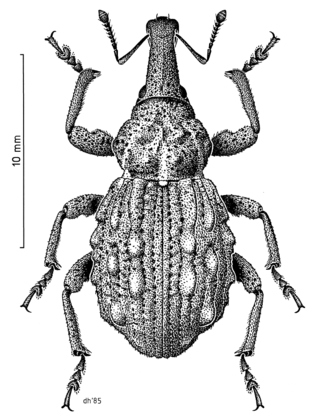
Hadramphus tuberculatus is a rare weevil endemic to Canterbury in the South Island of New Zealand. It was thought to be extinct in 1922 but was rediscovered in 2004.
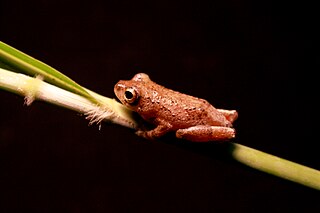
Hyperolius tuberculatus is a species of frog in the family Hyperoliidae. Its common name is rainforest reed frog. It ranges from the southeastern Nigeria to the Central Africa in Cameroon, western Central African Republic, Equatorial Guinea, Gabon, Republic of the Congo, and Democratic Republic of the Congo. It is also likely to occur in the Cabinda enclave of Angola.
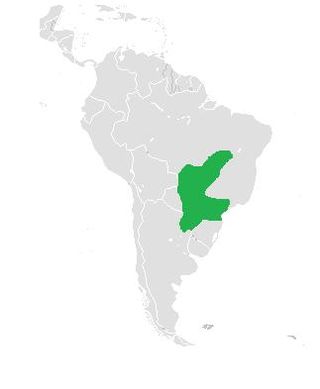
Vanderhaege's toad-headed turtle is a species of turtle in the family Chelidae. The species is endemic to South America.

The Vanikoro flying fox, also known locally as the basapine, is a species of bat in the family Pteropodidae. It has only been found in the Vanikoro island group located in the southern Solomon Islands. The species as a whole was originally known from just a few specimens collected sometime before 1930 but following surveys conducted on the island in the early 1990s did not detect this species again causing the Vanikoro flying fox to be listed as extinct. However, the species was rediscovered by a survey conducted in late 2014 which indicated a population in the high hundreds or low thousands and reported all observations.

Haematopinus is a genus of insects in the superfamily Anoplura, the sucking lice. It is the only genus in the family Haematopinidae, known commonly as the ungulate lice. All known species are of importance in veterinary medicine. These lice are some of the most economically important ectoparasites of domestic animals. Species infest many domesticated and wild large mammals, including cattle, horses, donkeys, swine, water buffalo, African buffalo, antelope, zebra, deer, and camels. The species Haematopinus tuberculatus has great importance in the water buffalo breading, since this louse is specific to buffaloes, being the main ectoparasite of the species, with important sanitary and economic burden. The Haematopinus tuberculatus is suspected to be involved in the transmission of diseases, such as anaplasmosis. The parasites are found infesting buffaloes in greater concentrations around the ears, base of horns, side of the neck, around the scrotum or udder, and especially at the tip of the tail.
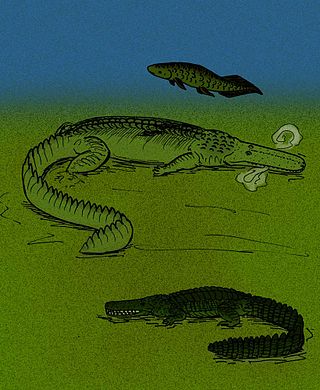
Retodus is an extinct genus of prehistoric lungfish found in Cretaceous-aged freshwater strata of Egypt, Algeria and Niger. The type species, R. tuberculatus, was named in 2006. It was originally named as a species of Ceratodus and Neoceratodus in 1963.
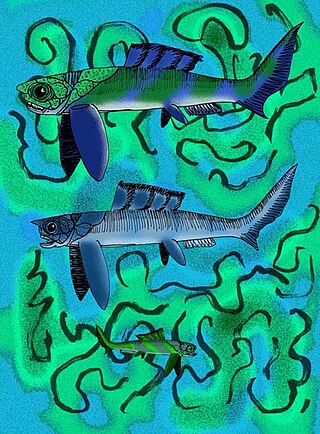
Rhinosteus is an extinct genus of small to medium selenosteid arthrodire placoderms of the Late Devonian known from the Upper Frasnian Kellwasserkalk facies of Bad Wildungen, Germany and Morocco.

Parmenini is a tribe of longhorn beetles of the subfamily Lamiinae.
Microtragus arachne is a species of beetle in the family Cerambycidae. It was described by Francis Polkinghorne Pascoe in 1865. It is known from Australia.
Microtragus basalis is a species of beetle in the family Cerambycidae. It was described by Lea in 1917. It is known from Australia.
Microtragus bifasciatus is a species of beetle in the family Cerambycidae. It was described by Lea in 1917. It is known from Australia.
Microtragus browni is a species of beetle in the family Cerambycidae. It was described by Carter in 1932. It is known from Australia.
Microtragus cristulatus is a species of beetle in the family Cerambycidae. It was described by Per Olof Christopher Aurivillius in 1917 and is known from Australia.
Microtragus echinatus is a species of beetle in the family Cerambycidae. It was described by Carter in 1926. It is known from Australia.
Microtragus luctuosus is a species of beetle in the family Cerambycidae. It was described by Shuckard in 1838. It is known from Australia.
Microtragus mormon is a species of beetle in the family Cerambycidae. It was described by Francis Polkinghorne Pascoe in 1865. It is known from Australia.
Microtragus multituberculatus is a species of beetle in the family Cerambycidae. It was described by Stephan von Breuning in 1954.
Microtragus quadrimaculatus is a species of beetle in the family Cerambycidae. It was described by Blackburn in 1892. It is known from Australia.
Microtragus senex is a species of beetle in the family Cerambycidae. It was described by White in 1846. It is known from Australia.








